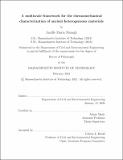| dc.contributor.advisor | Admir Masic. | en_US |
| dc.contributor.author | Maragh, Janille Maria. | en_US |
| dc.contributor.other | Massachusetts Institute of Technology. Department of Civil and Environmental Engineering. | en_US |
| dc.date.accessioned | 2021-05-25T18:21:25Z | |
| dc.date.available | 2021-05-25T18:21:25Z | |
| dc.date.copyright | 2021 | en_US |
| dc.date.issued | 2021 | en_US |
| dc.identifier.uri | https://hdl.handle.net/1721.1/130820 | |
| dc.description | Thesis: Ph. D., Massachusetts Institute of Technology, Department of Civil and Environmental Engineering, February, 2021 | en_US |
| dc.description | Cataloged from the official PDF of thesis. | en_US |
| dc.description | Includes bibliographical references (pages 167-188). | en_US |
| dc.description.abstract | Over the course of hundreds--or sometimes even thousands--of years, ancient building materials have survived environmental exposure, modifications, and restorations, often to an extreme degree. These processes, which have occurred from antiquity all the way to the present, have resulted in materials that are poorly understood both chemically and mechanically. This increases the difficulty of designing conservation, preservation, and restoration strategies to ensure that future generations have access to the same ancient marvels that are accessible today. This is further complicated by the inherent value of cultural heritage materials, which makes it challenging and impractical to obtain this information using large samples. | en_US |
| dc.description.abstract | In this work, a minimally invasive multiscale chemomechanical framework for the study and homogenization of heterogeneous composite materials of unknown composition is presented, with the ultimate goal being the chemomechanical characterization of ancient Roman mortar. First, advanced chemical characterization methods are used with computational techniques to better understand the phases present in a sample, and the application of these techniques to the study of ancient Roman mortar is presented. It is then demonstrated how the techniques developed for this study may be used for other applications, for example in the determination of ancient production technologies and in the understanding of the underlying mechanisms responsible for the durability and time resilience of ancient materials. | en_US |
| dc.description.abstract | In a chemical characterization study of a fragment of the Temple Scroll, the longest and most visually striking of the Dead Sea Scrolls, evaporitic sulfate salts that point to a unique production process are identified. The second half of this thesis demonstrates how chemistry is interfaced with mechanics in the chemomechanical homogenization framework. Instead of directly using ancient Roman concrete, which is of immense cultural value, the homogenization framework is tested on a series of modern mortars produced using ordinary Portland cement, which bear numerous similarities to ancient Roman mortars but are more readily accessible and more easily produced. First, scanning electron microscopy energy dispersive X-ray spectroscopy (SEM-EDS) is used with data clustering algorithms to identify the distribution of phases in each sample. | en_US |
| dc.description.abstract | Next, microindentation is used to assign mechanical properties to each of the chemically distinct phases identified, allowing for the generation of large-area high-resolution maps of mechanical properties. In the final stage of the framework, computational homogenization is performed: the chemomechanical maps are converted to finite element models, which are subjected to uniaxial compression and pure shear simulations to obtain estimates of the effective elastic properties of the samples, which are validated using laboratory compression testing data. Finally, the framework is applied to an ancient mortar sample using phase properties from the literature to estimate its effective elastic properties. | en_US |
| dc.description.statementofresponsibility | by Janille Maria Maragh. | en_US |
| dc.format.extent | 188 pages | en_US |
| dc.language.iso | eng | en_US |
| dc.publisher | Massachusetts Institute of Technology | en_US |
| dc.rights | MIT theses may be protected by copyright. Please reuse MIT thesis content according to the MIT Libraries Permissions Policy, which is available through the URL provided. | en_US |
| dc.rights.uri | http://dspace.mit.edu/handle/1721.1/7582 | en_US |
| dc.subject | Civil and Environmental Engineering. | en_US |
| dc.title | A multiscale framework for the chemomechanical characterization of ancient heterogeneous materials | en_US |
| dc.type | Thesis | en_US |
| dc.description.degree | Ph. D. | en_US |
| dc.contributor.department | Massachusetts Institute of Technology. Department of Civil and Environmental Engineering | en_US |
| dc.identifier.oclc | 1252627464 | en_US |
| dc.description.collection | Ph.D. Massachusetts Institute of Technology, Department of Civil and Environmental Engineering | en_US |
| dspace.imported | 2021-05-25T18:21:24Z | en_US |
| mit.thesis.degree | Doctoral | en_US |
| mit.thesis.department | CivEng | en_US |
